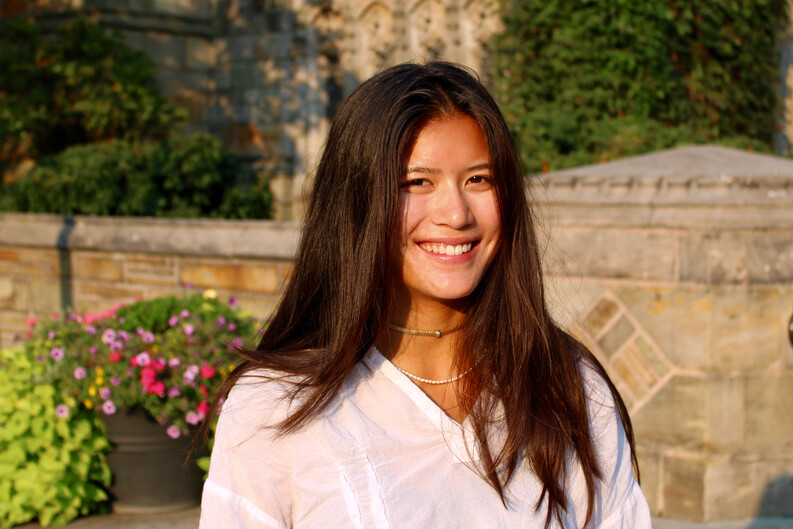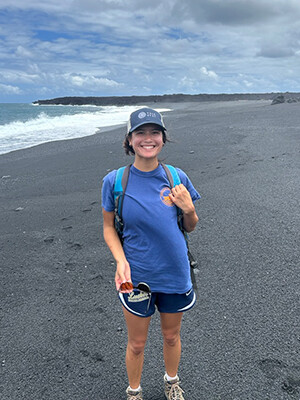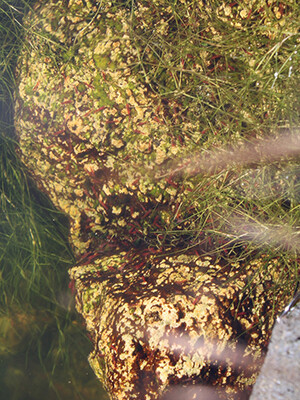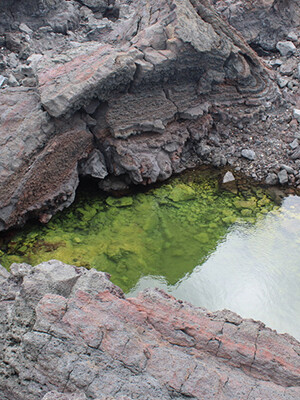Q&A: LEAP Student Grantee Grace Cajski on Storytelling to Conserve Hawai’ian Anchialine Pools

Grace Cajski is a senior at Yale College studying English and Environmental Studies with a concentration in marine conservation and a Law, Ethics, & Animals Program (LEAP) 2023 Student Grant recipient. Building on her work profiling the revival of ancient Hawai’ian fishponds as a 2021 LEAP grant recipient, Cajski used her 2023 grant to work with community organizations, including the Hui Loko, on Hawai’i Island to explore how storytelling can be used to conserve anchialine pools, a unique and critical Hawai’ian habitat.
LEAP Postgraduate Fellow Laurie Sellars spoke with Cajski about her LEAP student grant research. Their conversation has been edited for concision and clarity.
What are anchialine pools and what is their significance in the Hawai’ian archipelago? How did you become interested in these unique ecosystems?
Anchialine pools are bodies of water that have an underground connection to both seawater and freshwater: they are brackish groundwater-dependent ecosystems. They are present throughout the world — wherever there is rock like basalt that water can flow through — but the highest concentration of them is on the west coast of Hawai’i Island. For the Kona side of Hawai’i Island, anchialine pools play a variety of roles. For example, that part of the island doesn’t have streams, so anchialine pools are sources of drinking water. They are also epigeal habitat for ʻōpae ʻula, tiny shrimp that were used for bait, and plants in the anchialine pools provide habitat to the endangered pinao ʻula, the orange-black Hawai’ian damselfly. The pools are striking in the landscape: if you’ve ever walked on lava rock, it burns hot. If you stand on lava rock, look at the anchialine pools, and watch the water, you can see the underground water rippling and bubbling up. It's fascinating that there's this place with such crispness within a space that looks, at first glance, barren.

The pools are also culturally important. As sources of freshwater for a culture that's really tied to their ecology, the anchialine pools have come to be places that are settings for stories. People have told me stories where the human action occurs at anchialine pool. They talk about how these groundwater-dependent ecosystems have played into their family histories, how they have played into resource use, and then how that builds up into having a special place in the culture.
I became interested in these ecosystems in the summer of 2022, when I was working on a project for the Yale Program on Climate Change Communication and the Pulitzer Center about how climate change is affecting fishpond aquaculture on Oʻahu and Hawaiʻi Island. Fishponds are the oldest form of aquaculture on the Pacific Rim, and some of the fishpond caretakers were also anchialine pool caretakers. When I interviewed some of the fishpond caretakers, they mentioned anchialine pools, and I was fascinated because I had never heard of them. Oftentimes the fishponds under caretakers’ care are ones that their forebearers took care of, too, and that's what I see also in the anchialine pools: a lot of people are tied to it through their genealogy, and they weave themselves into the story of the pools. It was really inspiring and awesome to learn from them. And I was also fascinated that there are these tiny shrimps who bring into question everything we would assume about animals: they're tiny and cute and charismatic. They're in these awesome worlds unto themselves, but not really because they're actually connected to our world and to the ocean.
I’m generally interested in how coastal communities are caretakers of their waterways and how they are feeding themselves in a changing world — these pools align with those curiosities. I continued to email and text the caretakers questions about their work after the summer of 2022, and they encouraged me to stay in touch and keep learning. I saw this as a great opportunity for a thesis project — one that would provide benefits to the community, is in line with my course of study, has developed from my previous work, and is in the direction that I want to go in the future.
What does it mean to be a caretaker of anchialine pools?
The first thing I'll say is something that blew my mind when it was first said to me over the summer. I was at an anchialine pool that’s cared for by a nonprofit that wants to make sure that Hawai’ian children are connected to the land and learn from it. I went to talk with a caretaker who had been taking care of the pool for a long time and the other people working there about what they've done. I kept using the word “steward” to refer to him and the other people taking care of the pools, and he said that “steward” implies a hierarchy or obligation in a way that he didn't like. He preferred the word “caretaking.” His example was that you wouldn't say you “steward” your grandparents: that's a disrespectful and haughty thing to say. But you would say you take care of them. That conversation changed the way that I saw my word choice.

What does it mean to be a caretaker? It's a whole range of things from publishing scientific papers and going to conferences all the way to cleaning the bathrooms by the sites. It's taking out litter, it's making sure that other people can come visit an anchialine pool if it’s one that people are welcome to visit. It's removing invasive species by hand and net, which is tedious and — as I mentioned with the lava rock — really hot. Part of caretaking is also playing the role of security guard and correcting people: if a caretaker sees people swimming in an anchialine pool, a caretaker might tell them to get out of the water. Finally, caretaking the pools also includes educating people about them. One woman I spoke with went to talk to people in Ocean View, a relatively new development, and she was so surprised because the group were residents of the island and didn't know what anchialine pools are. So caretaking a is a wide variety of things from what I've seen, and a lot of it is also building community. For example, there’s an organization called the Hui Loko, which I've written about. This organization hosted me while I was in Hawai’i over the summer, and it's a cohort of different nonprofits or caretakers who are sharing knowledge, working, and organizing together. Part of the caretaking work is taking care of the caretaker: there's someone whose full-time job is to organize that for them.
What work did you undertake for your project?
My thesis is about storytelling and how storytelling can be a conservation tool, particularly through the lens of these pools, which are home to some of the rarest marine species on Earth. What does it mean that they've escaped the public's attention for so long? What does it mean that these pools are only known by the cool creatures they contain? For example, the ʻōpae are being collected by aquarists, and the other day I was talking with a childhood friend who’s studying how organisms swim through the water. He said that his lab has ʻōpae because they want to study how they swim, and I said, “Oh my gosh, I'm writing my thesis on the anchialine pools.” And he said, “What are anchialine pools?” It's interesting that we are able to separate the animal from their ecosystem, but there are so many other animals, too, and also the ecosystem is kind of an animal.
So this summer I wanted to collect material and stories for a story to write, which I collected through interviews and expeditions. First, I conducted interviews across the island, speaking with caretakers, with scientists, with teachers. I learned so much from them and loved hearing their stories. Second, I needed to gain the visceral story itself, and part of that was joining fieldwork expeditions, which were awesome. I hadn’t done fieldwork like that before and ended up going three times. They were all-day trips across the island to these newly formed anchialine pool sites. One time we went and saw the tracks of turtles that had just built and buried their nests: there were all kinds of cool things that happened.
The expeditions included two main components. One part of the work was using a drone to take photographs of the anchialine pools that we wouldn't be able to reach. You can stitch those drone photos together to create an ArcGIS Storymap, which is one of the newer technologies. It’s using cutting-edge, brand-new tools. This is a multimedia online story that can include call-out quotes, interactive maps, and photographs. If a thesis is something I’m doing in part for myself, my hope is that this StoryMap could be something for the caretakers to use: a product of this project that I can give to them to use as they wish, for example, sharing with potential visitors or linking on their websites.
With storytelling, we can reach people who have never and might never in their lifetimes visit anchialine pools. But our knowledge of the pools and our celebration of the caretakers and their work can drive action and support for anchialine pool conservation.”
—Grace Cajski
The second part of the fieldwork expedition was using an eDNA kit to measure the number of different species of shrimps in the pools. Traditionally, you count how many shrimps are in a pool by putting a PVC pipe open square on the pool and counting how many shrimps are in it within a one-minute timeframe. But there are some species of shrimp that have only been seen at one pool or four pools ever. So how do you find these super rare species? Typically, you squat at the pool until you see them: sometimes time is limited, sometimes people miss a shrimp. And the other thing is when you're standing by the pools, it's like you're doing gymnastics: it's very physically demanding. It's about an hour and a half hike out on the lava field: the rocks around you are 30 feet high and there are cliffs. It's a lot of scrambling. The eDNA kit lets people see what's in the pool without having to stand there. The folks on the expedition I joined allowed me to use the kit. They had the citizen science eDNA kit, which is a heavy bread box-sized object. To use it, you put a filter on the kit and put it into the water, and it sucks up the water and catches the DNA in the filter. Then you put what you’ve collected into a bag and send it to the lab for analysis. Given the physicality involved in getting to the pool, a lot of the fieldwork with this kit is transporting the eDNA cell to the anchialine pool, and then the rest of it goes pretty quickly.
I also went on other, non-fieldwork expeditions. I wanted to see how the public interacts with anchialine pools, and that included going to Volcanoes National Park where there are anchialine pools because there's lava flow. They had this display of the ʻōpae, and I was watching as people passed it: it was interesting to see people looking because it is cool to see the ʻōpae. I was also curious about how we treat charismatic animals differently. To answer that question, I went on a manta ray dive, and the craziest thing happened: someone proposed to someone on the dive. No one would ever do that for an anchialine pool. I'm including that in my story, too.
Across all parts of my project, I admired the dedication, warmth, eagerness, and care that the caretakers and scientists have. They took the time out of their days to speak with me and show me around and share their stories. I’m very grateful.
After completing your summer work, how do you believe storytelling can be used as a conservation tool for anchialine pools?

It’s not a novel claim that storytelling is a powerful, enduring way to transfer ideas. The anchialine pool caretakers tell stories. But I think new technologies like ArcGIS StoryMaps allow us to tell stories in a new manner, with multimedia and to a broader audience. I think nonfiction essays — I’m inspired by Annie Dillard right now — can be so beautiful and compelling (it’s my favorite art form). The claim I’m making is that with storytelling, we can reach people who have never and might never in their lifetimes visit anchialine pools. But our knowledge of the pools and our celebration of the caretakers and their work can drive action and support for anchialine pool conservation—and open our eyes to the wonder and importance of marine ecosystems. I think plastic pollution is a great example of how we can have an impact on parts of the world that we will never see: letʻs leverage that for anchialine pools.
There is no con to being more aware of the awesome possibilities on earth. There is no con to being more aware of different modes of interacting with the environment (how people care for these pools and care for the life within them). There is no con to learning and learning with humility. I’m saying we can broaden our perspectives with stories, and wide-reaching, accessible stories will reach diverse audiences.
This project expands beyond the work you did this summer. What lies ahead? Are there/Will there be ways in which members of the public can engage with your work?
Now I am in the process of writing a 10,000-word piece of nature writing about the anchialine pools, which I will submit for publication to a national magazine. It is for a broad audience that is interested in nature but does not know about anchialine pools yet. In general, I’m interested in coastal food systems and community resilience. I’m interested in aquaculture, stewardship, and caretaking of the environment. How can and have coastal communities taken care of — or even augmented — the nearshore marine environment? How can we take care of the local ecosystem by participating in the local food chain? I’m not sure where these questions will take me next. But if people are interested in learning more about my work, they can read the articles I’ve written. More than that, I encourage you to dig deeper and read other articles and stories, reach out to these groups I’ve written about. If you are in an area with anchialine pools or fishponds you could also join community workdays!


